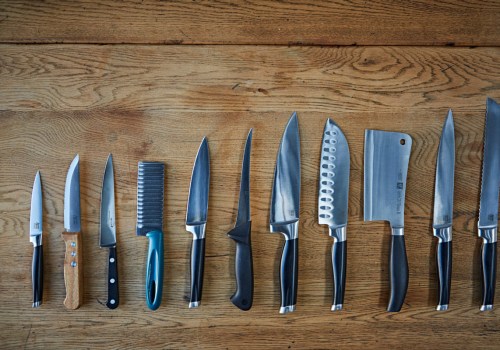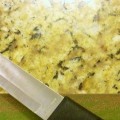Cooking is an art and a science, and mastering it requires more than just a few ingredients and a stove. One of the most important skills to have in the kitchen is the proper use of knives—and unfortunately, it's one that is often overlooked. Properly using knives in the kitchen can mean the difference between a delicious meal and a dangerous accident. To help ensure that you stay safe in the kitchen, here are some tips for safely using knives. Kitchen knives are an essential tool in any home, but using them properly and safely is of utmost importance to avoid accidents.
There are a variety of types of kitchen knives that are used for different tasks – each with its own specific purpose. A chef's knife is a large, multi-purpose knife that can be used for slicing, dicing, and chopping; a serrated knife is best for cutting through tough crusts, such as bread and tomatoes; and a paring knife is great for peeling fruits and vegetables. In addition to the type of knife you’re using, it’s important to understand the proper technique for slicing, dicing, and chopping. When holding the knife, your thumb and index finger should be on either side of the blade.
Make sure to keep your other fingers out of the way as you move the knife through food. It’s also important to keep your non-dominant hand at a safe distance from the blade as you work.
Slicing
requires a smooth and even motion with your knife. For dicing, hold the item firmly with your non-dominant hand while using a rocking motion with the knife.And when chopping, use a downward motion with the blade while keeping your fingers curled under. To keep your knives sharp, there are a few tools that can help. A honing steel is an essential tool for maintaining the edges on kitchen knives, while a sharpening stone or electric sharpener can help to restore dull blades. When it comes to cleaning and storing your knives, safety should be top of mind.
Always dry your knives thoroughly after washing to avoid rusting. And store them safely in either a knife block or magnetic strip. In the event that you do accidentally cut yourself with a knife, it’s important to handle it carefully and seek medical attention if necessary.
What To Do If You Cut Yourself
The first and most important step to take if you cut yourself while using a kitchen knife is to remain calm and not panic. Immediately apply pressure to the wound with a clean cloth or paper towel, and elevate the affected limb if possible.You should also rinse the wound with cool water to remove any debris or bacteria. If the wound is deep or bleeding heavily, seek medical attention as soon as possible. Before seeking medical attention, make sure to thoroughly clean the wound with soap and water, and cover it with a clean bandage. It is also important to sterilize any kitchen knives that were used in order to prevent further infection. In some cases, it may be necessary to get a tetanus shot or antibiotics. Your doctor may also provide additional advice on how to best care for the wound, so it is important to follow his or her instructions.
Safety Tips for Cleaning and Storing Your Knives
When it comes to cleaning and storing your kitchen knives, safety should be your top priority.It's important to always dry your knives thoroughly after washing to avoid rusting. You can store them in a knife block or magnetic strip, both of which will keep your blades away from other kitchen items, preventing them from being damaged. Additionally, make sure that the knife block or strip is out of reach from children. When cleaning your knives, avoid using abrasive materials, such as steel wool or a wire brush.
These can damage the blade and make it more difficult to sharpen. Instead, use a soft sponge or cloth with a mild soap and water solution. After cleaning, be sure to dry the blade completely with a dry cloth and store it in the appropriate place. To prevent dulling, it’s best to use a honing steel regularly to keep the edge sharp.
This will also help to prevent accidents in the kitchen. Never use your honing steel as a substitute for sharpening. Instead, use a sharpening stone or a manual knife sharpener when needed.
Proper Knife Technique
Slicing, Dicing, and Chopping: When it comes to using knives in the kitchen, proper technique is essential for safety and efficiency. For slicing, you should hold the knife with your index finger on the bolster (where the blade meets the handle) and your thumb on top of the blade.The blade should be facing away from you, and you should use a steady back and forth motion to cut your food. For dicing, you should hold the knife in the same way, but use a rocking motion to make small, uniform cubes. To chop, you should hold the knife in a similar way, but use a quick up and down motion with your wrist. When using any knife, it's important to keep your fingers tucked away from the blade.
You should also practice cutting on a cutting board or other surface that can absorb the impact of your knife.
Keeping Your Knives Sharp
Keeping your knives sharp is essential for having safe and effective use of them in the kitchen. Using a honing steel, sharpening stone, or electric sharpener can help make sure your knives are always in top condition. A honing steel is a long metal rod with a rough surface. By running the blade of your knife along the surface of the honing steel, you can realign the edges of the blade and make sure it's still sharp.This should be done regularly after each use to keep the knife in good condition. Sharpening stones are another popular way to sharpen knives. These stones usually come in two different textures, coarse and fine. Start with the coarse stone to remove any large nicks or chips from the blade, then move to the finer stone to sharpen it up.
Finally, electric sharpeners are an easy way to keep your knives sharp without a lot of effort. Most electric sharpeners have several slots for different levels of sharpening and are very easy to use. No matter which method you choose, keeping your knives sharp is essential for safe and effective use in the kitchen. Regular honing, sharpening, and electric sharpening will help ensure that your knives stay in top condition.
Types of Kitchen Knives
When it comes to kitchen knives, there are several different types to choose from. Each type of knife has its own unique purpose and can make kitchen tasks a lot easier.Here are the most commonly used kitchen knives and what they're best used for:Chef's Knife:The chef's knife is the most versatile type of kitchen knife and is often used for chopping, slicing, and dicing. It typically has a curved blade that tapers to a point and is usually between 8 and 10 inches long. This type of knife is great for cutting through large pieces of food.
Serrated Knife:
Serrated knives are also known as bread knives or tomato knives. They have a wavy blade that is designed to cut through foods with tough exteriors and soft interiors, like tomatoes or crusty bread.The saw-like teeth allow it to easily cut through hard surfaces without damaging the softer interior.
Paring Knife:
Paring knives are smaller than chef's knives and are usually about 3 to 4 inches long. They have a sharp, pointed blade that is ideal for peeling fruits and vegetables, as well as cutting small pieces of food. Paring knives are also great for intricate tasks like de-veining shrimp.Boning Knife:
Boning knives are specifically designed for removing bones from meat and fish. They have a thin, flexible blade that makes it easy to get around the bones without damaging the meat.Boning knives come in a variety of sizes, so you can choose one that is suitable for the type of meat you are working with.
Utility Knife:
Utility knives are in between the size of a chef's knife and a paring knife. They have a straight blade that is usually 5 to 8 inches long. This type of knife is great for slicing sandwiches and other small pieces of food. In conclusion, using knives safely in the kitchen is essential for avoiding accidents. We have covered different types of kitchen knives, proper technique for slicing, dicing, and chopping, and safety tips for cleaning and storing your knives.It is important to practice proper techniques and take safety precautions when using kitchen knives to ensure everyone's safety.






Leave Reply